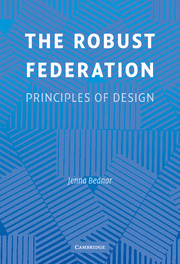Book contents
1 - Constituting the Robust Federation
Published online by Cambridge University Press: 05 June 2012
Summary
How can a federal constitution—mere words on paper—produce a government that is strong, flexible, and resilient? A federal constitution creates distinct governments endowed with different responsibilities. The boundaries between national and state governmental authority are set with goals in mind; to be effective, these boundaries must be maintained. At the same time, the constitution is not written to satisfy a single moment, but needs to remain relevant in perpetuity. Over time, owing to changing circumstances and intentions, the authority boundaries sometimes must be redrawn. The tension between strength and flexibility, commitment and mutability, creates a conundrum inherent to federal constitutional design. Making the problem all the more vexing, the safeguards that uphold the boundaries depend on humans, acting as both individuals and collectives, and are thus flawed. How successful federations overcome this apparent contradiction, enforcing the rules while maintaining flexibility—and do so with imperfect components—is the focus of this book.
This book builds a logic of robust federal design. I offer a set of general principles of constitutional construction and institutional performance that can be adapted to fit local conditions. I diagnose the inherent weakness of federalism: the temptation for constituent governments to exploit the union for their own gain. I show how the constitution constructs safeguards to prevent these transgressions, but each is imperfect and none is sufficient. As a collaborative system, however, the safeguards overcome one another's weaknesses to protect the federal boundaries against manipulation while admitting beneficial adjustments.
- Type
- Chapter
- Information
- The Robust FederationPrinciples of Design, pp. 1 - 17Publisher: Cambridge University PressPrint publication year: 2008



